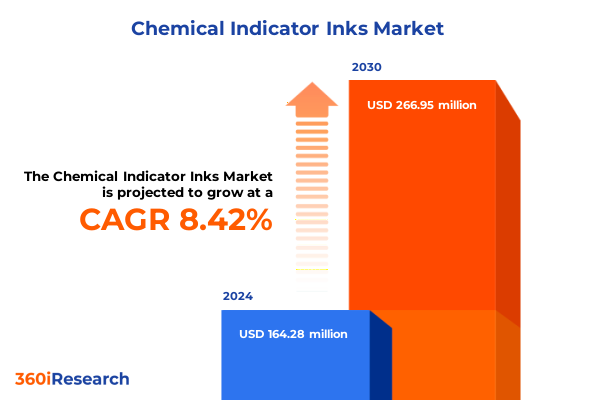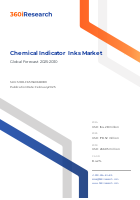The Chemical Indicator Inks Market size was estimated at USD 164.28 million in 2024 and expected to reach USD 178.52 million in 2025, at a CAGR 8.42% to reach USD 266.95 million by 2030.

Introduction to the Emerging Importance of Chemical Indicator Inks
Chemical indicator inks have emerged as a critical enabler of safety, quality assurance, and regulatory compliance across a diverse array of industries. Leveraging responsive color-change chemistries, these inks provide clear visual confirmation of environmental conditions or process milestones-ranging from sterilization validation in healthcare to temperature monitoring in food logistics. Innovations in reversible and irreversible thermochromic formulations, combined with photochromic and gas-sensitive chemistries, empower stakeholders to gain immediate insights without relying on complex instrumentation. As global supply chains grow increasingly intricate and regulatory scrutiny intensifies, the demand for reliable, low-cost, and easy-to-interpret indicators is surging. This convergence of technological advancement and operational necessity sets the stage for a pivotal shift in how organizations across automotive, food & beverage, healthcare, and industrial segments monitor safety and quality. In this context, understanding the evolving landscape of chemical indicator inks becomes paramount for decision-makers seeking competitive advantage and compliance assurance.
Transformative Technological and Sustainability Shifts Reshaping the Market
Over the past three years, the chemical indicator ink market has undergone transformative shifts driven by digitalization, sustainability imperatives, and smarter packaging demands. The rapid adoption of digital printing and inkjet technologies has enabled high-resolution, on-demand production of indicators directly onto flexible substrates, reducing lead times and material waste. Meanwhile, heightened environmental regulations have accelerated the transition toward biodegradable materials and non-toxic dyes, prompting formulators to develop novel organic chemistries that meet both performance and eco-compliance standards. In parallel, the proliferation of connected devices and Internet of Things (IoT) platforms has ushered in new use cases: photochromic inks integrated with optical sensors enable remote gas detection alerts, while reversible thermochromic labels can communicate real-time temperature excursions to cloud-based monitoring systems. The COVID-19 pandemic further underscored the critical role of sterilization monitoring inks in healthcare settings, driving innovation in irreversible chemistries that deliver tamper-proof validation. Collectively, these shifts are redefining the competitive landscape, encouraging cross-industry collaboration and investment in advanced material science.
Navigating the Impact of 2025 U.S. Tariffs on Supply Chain Dynamics
As of 2025, newly imposed United States tariffs on raw materials, including select metallic oxides and specialty dyes, have reshaped cost structures and sourcing strategies across the chemical indicator ink supply chain. Manufacturers that rely on imported inorganic salts and metallic precursors now face increased input costs, which they have partly offset by optimizing formulations and by collaborating with domestic suppliers of organic biodegradable polymers. Some producers have shifted toward local manufacturing hubs to minimize cross-border logistics exposure, while others have renegotiated contracts to lock in favorable pricing before additional duties take effect. Meanwhile, end-user industries with high compliance requirements, such as pharmaceutical packaging and surgical instrument tracking, have absorbed incremental price adjustments by highlighting the cost of non-compliance and product recalls. These adaptations underscore the sector’s resilience: rather than stalling innovation, the tariff landscape has spurred resourcefulness in material selection and supply chain realignment, ultimately strengthening regional capabilities and mitigating future regulatory uncertainties.
In-Depth Insights Across Six Key Market Segments
Segment analysis reveals a multi-faceted market structure. By type, the color-changing inks segment leads adoption in general-purpose applications, though photochromic chemistries are gaining traction for UV-triggered security labels. Thermochromic inks, both irreversible and reversible, dominate temperature-sensitive use cases, with irreversible formulations preferred for tamper-evident use and reversible systems capturing high-volume food transport monitoring.In application terms, gas detection continues to expand within industrial safety, while quality control applications-spanning food quality monitoring and pharmaceutical quality control-drive demand for ultra-high-precision indicators. Sterilization monitoring maintains its stronghold in healthcare, and temperature indicators underpin cold-chain logistics.By material, inorganic metallic oxides and salts deliver robust performance in harsh environments, yet growing regulatory pressure elevates the role of biodegradable materials and non-toxic dyes from the organic materials category. End-user industry segmentation highlights diversified adoption: within automotive, engine components leverage thermal labels for maintenance schedules, and interior monitoring ensures cabin safety standards; in the food and beverage sector, fresh produce supply chains employ single-use thermal strips, while processed food packaging utilizes color-change labels for temperature abuse alerts; healthcare applications encompass pharmaceutical packaging markers and surgical instrument tracking; industrial machinery and manufacturing facilities integrate reusable indicators into preventative maintenance protocols.Technology segmentation underscores digital printing’s ascendancy, followed by flexography for large-run production, inkjet for customized runs, and screen printing for specialty substrates. Ink formulation insights point to solvent-based inks retaining legacy applications, ultra-violet curing inks accelerating in rapid-dry workflows, and water-based inks aligning with green chemistry mandates.
This comprehensive research report categorizes the Chemical Indicator Inks market into clearly defined segments, providing a detailed analysis of emerging trends and precise revenue forecasts to support strategic decision-making.
- Type
- Application
- Material
- End-user Industry
- Technology
- Ink Formulation
Critical Regional Dynamics Shaping Adoption and Innovation
Regional dynamics reveal divergent growth drivers and strategic priorities. In the Americas, robust pharmaceutical and food quality regulations underpin high penetration of both irreversible and reversible thermochromic inks, while a well-established manufacturing infrastructure accelerates digital printing integration. Over in Europe, Middle East & Africa, stringent environmental directives and circular economy initiatives have propelled demand for biodegradable and non-toxic organic materials, with major packaging players collaborating on standardized indicator formats to streamline cross-border compliance. Meanwhile, Asia-Pacific markets showcase rapid industrialization in automotive and healthcare sectors, supported by cost-competitive local production and a strong appetite for flexographic and inkjet technologies. Emerging economies in Southeast Asia are experimenting with innovative photochromic security labels, while established hubs in Northeast Asia invest heavily in R&D for next-generation gas detection chemistries. These regional contrasts define both opportunity zones and areas requiring tailored market approaches.
This comprehensive research report examines key regions that drive the evolution of the Chemical Indicator Inks market, offering deep insights into regional trends, growth factors, and industry developments that are influencing market performance.
- Americas
- Asia-Pacific
- Europe, Middle East & Africa
Profiling Major Participants Driving Market Advancement
Leading stakeholders span a broad spectrum of specialties. 3M Company leverages decades of adhesive and coating expertise to deliver integrated indicator solutions across healthcare and industrial segments. APV Engineered Coatings specializes in custom-engineered formulations, enabling rapid prototyping for emerging applications. CMYK Engineering’s precision manufacturing capabilities support high-volume digital printing of complex indicator patterns. Getinge Group and STERIS Corporation have established market leadership in sterilization monitoring, offering validated chemistries for autoclave and hydrogen peroxide processes. Hu-Friedy Mfg. Co., LLC and Medline Industries, Inc. drive adoption in surgical instrument and pharmaceutical packaging. LA-CO Industries, Inc. and Propper Manufacturing Co., Inc. supply robust solvent-based and water-based inks to automotive and industrial clients. NiGK Corporation’s thermochromic specialties cater to niche temperature-control applications, while Shanghai Jianzhong Medical Packaging Co., Ltd. supports regional healthcare markets with compliant packaging indicators. Tapecon, Inc., Terragene and True Indicating, LLC focus on novel bioreagents and gas-sensitive labels, pushing the boundaries of indicator sensitivity and stability. Collectively, these companies illustrate the ecosystem’s depth-from raw material innovation through end-use system integration.
This comprehensive research report delivers an in-depth overview of the principal market players in the Chemical Indicator Inks market, evaluating their market share, strategic initiatives, and competitive positioning to illuminate the factors shaping the competitive landscape.
- 3M Company
- APV Engineered Coatings
- CMYK Engineering
- Getinge Group
- Hu-Friedy Mfg. Co., LLC
- LA-CO Industries, Inc.
- Medline Industries, Inc.
- NiGK Corporation
- Propper Manufacturing Co., Inc.
- Shanghai Jianzhong Medical Packaging Co., Ltd.
- STERIS Corporation
- Tapecon, Inc.
- Terragene
- True Indicating, LLC
Strategic Actions to Enhance Competitiveness and Resilience
To capitalize on emerging opportunities, industry leaders should first diversify raw material sourcing to mitigate tariff‐related disruptions, exploring partnerships with domestic suppliers of biodegradable polymers and non-toxic dyes. Second, investing in digital printing infrastructure and in-house technical capabilities will unlock rapid customization and reduce production lead times. Third, cross-sector collaborations-linking packaging OEMs, materials scientists, and end-user compliance teams-can accelerate standardization of indicator formats and streamline regulatory approvals. Fourth, prioritizing R&D toward next-generation chemistries, such as photochromic multi-phase inks and sensor-integrated dye matrices, will position companies at the forefront of IoT-enabled monitoring. Fifth, establishing regional innovation hubs-particularly in Asia-Pacific and EMEA-can optimize product-market fit and support localized regulatory engagement. Finally, embedding sustainability metrics into product development roadmaps will resonate with environmentally conscious customers and align with global circular economy goals.
Explore AI-driven insights for the Chemical Indicator Inks market with ResearchAI on our online platform, providing deeper, data-backed market analysis.
Ask ResearchAI anything
World's First Innovative Al for Market Research
Synthesizing Market Drivers and the Path Forward
The chemical indicator ink sector stands at the intersection of material science innovation, regulatory evolution, and digital transformation. Continued momentum will hinge on the industry’s ability to balance performance with sustainability, to navigate trade and tariff landscapes, and to foster collaborative ecosystems that expedite product commercialization. As end users demand ever-more precise, cost-effective, and environmentally responsible solutions, organizations that leverage advanced digital printing technologies, diversified formulations, and data-driven monitoring platforms will secure a leadership position. By proactively addressing supply chain vulnerabilities and by prioritizing R&D in emerging chemistries, the industry can sustain its upward trajectory and deliver the next generation of smart, responsive ink systems.
This section provides a structured overview of the report, outlining key chapters and topics covered for easy reference in our Chemical Indicator Inks market comprehensive research report.
- Preface
- Research Methodology
- Executive Summary
- Market Overview
- Market Dynamics
- Market Insights
- Cumulative Impact of United States Tariffs 2025
- Chemical Indicator Inks Market, by Type
- Chemical Indicator Inks Market, by Application
- Chemical Indicator Inks Market, by Material
- Chemical Indicator Inks Market, by End-user Industry
- Chemical Indicator Inks Market, by Technology
- Chemical Indicator Inks Market, by Ink Formulation
- Americas Chemical Indicator Inks Market
- Asia-Pacific Chemical Indicator Inks Market
- Europe, Middle East & Africa Chemical Indicator Inks Market
- Competitive Landscape
- ResearchAI
- ResearchStatistics
- ResearchContacts
- ResearchArticles
- Appendix
- List of Figures [Total: 28]
- List of Tables [Total: 635 ]
Contact Ketan Rohom to Secure Your Detailed Market Analysis Report
To acquire the full market research report and gain actionable insights tailored to your strategic objectives, reach out to Ketan Rohom, Associate Director, Sales & Marketing, at [email protected]. Begin your journey toward optimized supply chains, innovative product pipelines, and data-driven growth by connecting today.

- How big is the Chemical Indicator Inks Market?
- What is the Chemical Indicator Inks Market growth?
- When do I get the report?
- In what format does this report get delivered to me?
- How long has 360iResearch been around?
- What if I have a question about your reports?
- Can I share this report with my team?
- Can I use your research in my presentation?




